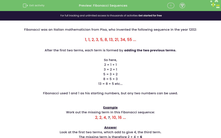Fibonacci was an Italian mathematician from Pisa, who invented the following sequence in the year 1202:
1, 1, 2, 3, 5, 8, 13, 21, 34, 55 ...
After the first two terms, each term is formed by adding the two previous terms.
So here,
2 = 1 + 1
3 = 2 + 1
5 = 3 + 2
8 = 5 + 3
13 = 8 + 5 etc...
Fibonacci used 1 and 1 as his starting numbers, but any two numbers can be used.
Example
Work out the missing term in this Fibonacci sequence:
2, 2, 4, ?, 10, 16 ...
Answer
Look at the first two terms, which add to give 4, the third term.
The missing term is therefore 2 + 4 = 6
Check that the next term works too
4 + 6 = 10
6 + 10 = 16
Let's have a go at some questions now.









